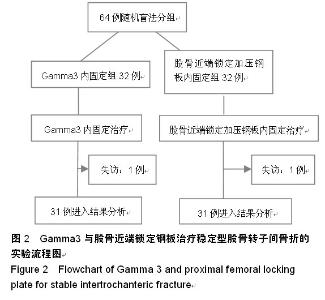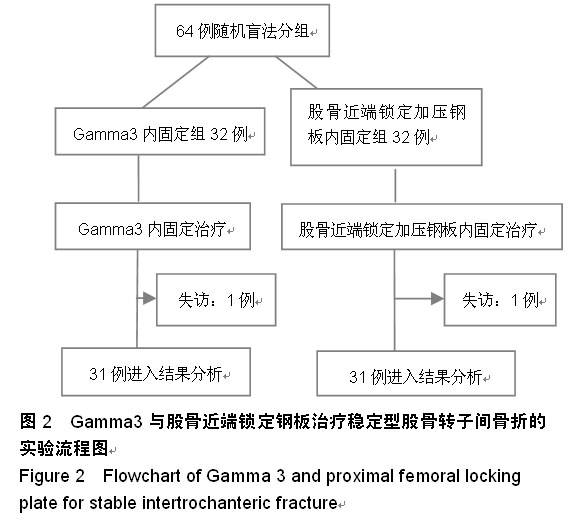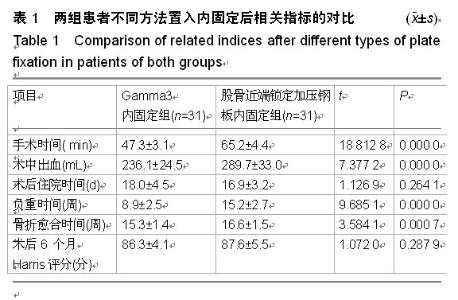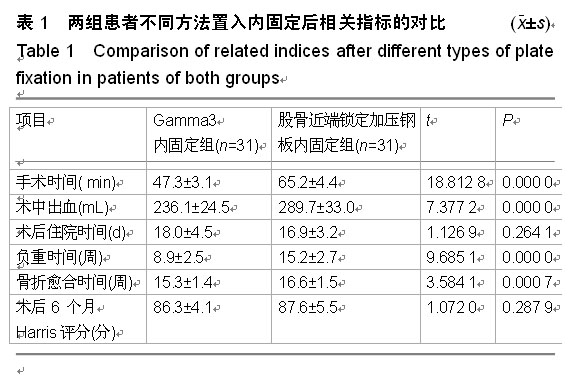Chinese Journal of Tissue Engineering Research ›› 2015, Vol. 19 ›› Issue (22): 3584-3589.doi: 10.3969/j.issn.2095-4344.2015.22.026
Previous Articles Next Articles
Locking plate fixation versus the third generation of the gamma nail fixation for intertrochanteric fractures: biomechanical stability
Gui Shu-guang, Li De-bin, Liu An-ping, Hu Xiao-dong
- Department of Orthopedic Surgery, the Second People’s Hospital of Panzhihua, Panzhihua 617000, Sichuan Province, China
-
Received:2015-03-24Online:2015-05-28Published:2015-05-28 -
About author:Gui Shu-guang, Associate chief physician, Department of Orthopedic Surgery, the Second People’s Hospital of Panzhihua, Panzhihua 617000, Sichuan Province, China
CLC Number:
Cite this article
Gui Shu-guang, Li De-bin, Liu An-ping, Hu Xiao-dong. Locking plate fixation versus the third generation of the gamma nail fixation for intertrochanteric fractures: biomechanical stability [J]. Chinese Journal of Tissue Engineering Research, 2015, 19(22): 3584-3589.
share this article
| [1] 王亦璁,姜保国.骨与关节损伤[M].5版.北京:人民卫生出版社,2012: 1160-1163.
[2] Bozic KJ, Kurtz SM, Lau E, et al. The epidemiology of revision total hip arthroplasty in the United States. J Bone Joint Surg Am. 2009;91(1):128-133.
[3] 谢晶晶,宋烜,王占朝,等.内外侧锁定钢板固定胫骨远端骨折的比较[J].中国组织工程研究,2013,17(43):7636-7641.
[4] van Embden D, Rhemrev SJ, Meylaerts SA, et al. The comparison of two classifications for trochanteric femur fractures: the AO/ASIF classification and the Jensen classification. Injury. 2010;41(4):377-381.
[5] Tei K, Kubo S, Matsumoto T, et al. Combined osteochondral fracture of the posterolateral tibial plateau and Segond fracture with anterior cruciate ligament injury in a skeletally immature patient. Knee Surg Sports Traumatol Arthrosc. 2012; 20(2):252-255.
[6] Peleg E, Mosheiff R, Liebergall M, et al. A short plate compression screw with diagonal bolts--a biomechanical evaluation performed experimentally and by numerical computation. Clin Biomech (Bristol, Avon). 2006;21(9):963-968.
[7] 谭三智,黄桂填. DHS和PFN治疗股骨粗隆间骨折的疗效分析[J].实用医学杂志,2010,26(18):3395-3396.
[8] Canale TS,Beaty JH.坎贝尔骨科手术学[M].王岩,译.11版.北京:人民军医出版社,2009:2538-2539.
[9] 鲁英,罗先正.203例股骨粗隆间骨折治疗分析[J].骨与关节损伤杂志,1991,6(1):7-9.
[10] Bojan AJ, Beimel C, Speitling A, et al. 3066 consecutive Gamma Nails. 12 years experience at a single centre. BMC Musculoskelet Disord. 2010;11:133.
[11] Peltola EK, Mustonen AO, Lindahl J, et al. Segond fracture combined with tibial plateau fracture. AJR Am J Roentgenol. 2011;197(6):W1101-1104.
[12] Liu M, Yang Z, Pei F, et al. A meta-analysis of the Gamma nail and dynamic hip screw in treating peritrochanteric fractures. Int Orthop. 2010;34(3):323-328.
[13] Veitch SW, Stroud RM, Toms AD. Compaction bone grafting in tibial plateau fracture fixation. J Trauma. 2010;68(4):980-983.
[14] 徐耀增,耿德春,王现彬,等.防旋股骨近端髓内钉与第三代Gamma钉治疗老年股骨转子间骨折的对比研究[J].中华创伤杂志,2011, 27(1):33-37.
[15] Pernaa K, Koski I, Mattila K, et al. Bioactive glass S53P4 and autograft bone in treatment of depressed tibial plateau fractures - a prospective randomized 11-year follow-up. J Long Term Eff Med Implants. 2011;21(2):139-148.
[16] 胡力.股骨转子间骨折的内固定器应用进展[J].中国矫形外科杂志, 2013,21(10):989-992.
[17] 国家体育总局. 2010年国民体质监测公报.2011-9-2.
[18] Arjona-Giménez C, Navarrete-Jiménez JD, Nieto-Rodríguez O. Lobenhoffer approach to stabilize fractures of the posteromedial tibial plateau. Acta Ortop Mex. 2013;27(6):380-384.
[19] Zha GC, Chen ZL, Qi XB, et al. Treatment of pertrochanteric fractures with a proximal femur locking compression plate. Injury. 2011;42(11):1294-1299.
[20] Vasanad GH, Antin SM, Akkimaradi RC, et al. "Surgical management of tibial plateau fractures - a clinical study". J Clin Diagn Res. 2013;7(12):3128-3130.
[21] Seral B, García JM, Cegoñino J, et al. Finite element study of intramedullary osteosynthesis in the treatment of trochanteric fractures of the hip: Gamma and PFN. Injury. 2004;35(2): 130-135.
[22] Sitthiseripratip K, Van Oosterwyck H, Vander Sloten J, et al. Finite element study of trochanteric gamma nail for trochanteric fracture. Med Eng Phys. 2003;25(2):99-106.
[23] Ferreira N, Marais LC. Bicondylar tibial plateau fractures treated with fine-wire circular external fixation. Strategies Trauma Limb Reconstr. 2014;9(1):25-32.
[24] Albuquerque RP, Hara R, Prado J, et al. Epidemiological study on tibial plateau fractures at a level I trauma center. Acta Ortop Bras. 2013;21(2):109-115.
[25] Rydell N. Biomechanics of the hip-joint. Clin Orthop Relat Res. 1973;(92):6-15.
[26] 李必奎,陈周兵,徐富生.股骨近端锁定钢板治疗股骨转子间骨折[J].中国修复重建外科杂志,2011,25(10):1273-1275.
[27] Dall'oca C, Maluta T, Lavini F, et al. Tibial plateau fractures: compared outcomes between ARIF and ORIF. Strategies Trauma Limb Reconstr. 2012;7(3):163-175.
[28] Norris R, Bhattacharjee D, Parker MJ. Occurrence of secondary fracture around intramedullary nails used for trochanteric hip fractures: a systematic review of 13,568 patients. Injury. 2012; 43(6):706-711.
[29] Flautt W, Miller J, Ratcliff JR. Lateral tibial plateau fracture. J Orthop Sports Phys Ther. 2012;42(9):819.
[30] Werner CM, Scheyerer MJ, Schmitt J, et al. Minimally invasive balloon-assisted reduction and internal fixation of tibial plateau fractures. Unfallchirurg. 2012;115(12): 1126-1132.
[31] 张波,潘显明,权毅,等.三种内固定器治疗股骨颈骨折的临床观察及生物力学分析[J].西南国防医药,2002,12(3):210-212.
[32] 孙强,许平安,郑加法.三种手术方式固定不稳定性股骨转子间骨折的生物力学研究[J].中华创伤杂志,2012,28(12):1078-1082.
[33] Windolf J, Hollander DA, Hakimi M, et al. Pitfalls and complications in the use of the proximal femoral nail. Langenbecks Arch Surg. 2005;390(1):59-65.
[34] 刘瑞波,白音,孔令英,等.力臂式外固定器治疗股骨粗隆间骨折实验研究和临床应用[J].中国骨伤,1999,12(2):20-23.
[35] Okcu G, Ozkayin N, Okta C, et al. Which implant is better for treating reverse obliquity fractures of the proximal femur: a standard or long nail? Clin Orthop Relat Res. 2013;471(9): 2768-2775.
[36] 张俊,王劲,何爱咏.股骨近端锁定钢板置入内固定修复老年股骨转子间陈旧性骨折[J].中国组织工程研究,2014,18(22): 3475-3480.
[37] Gadegone W, Lokhande V, Salphale Y, et al. Long proximal femoral nail in ipsilateral fractures proximal femur and shaft of femur. Indian J Orthop. 2013;47(3):272-277.
[38] 孟位明,李彦眉,许红生,等.股骨转子下骨折植入物髓外及髓内固定治疗的规范化[J].中国组织工程研究,2014,18(22): 3587- 3592.
[39] Kumar R, Singh RN, Singh BN, et al . Comparative prospective study of proximal femoral nail and dynamic hip screw in treatment of intertrochanteric fracture femur. J Clin Orthop Trauma. 2012;390(1):28-36.
[40] 胡阿威,喻爱喜,夏成焱,等.四种内固定方法治疗老年股骨转子间骨折的对比研究[J].中华全科医师杂志,2013,12(3):185-188.
[41] Andruszkow H, Frink M, Frömke C, et al. Tip apex distance, hip screw placement, and neck shaft angle as potential risk factors for cut-out failure of hip screws after surgical treatment of intertrochanteric fractures. Int Orthop. 2012;36(11): 2347- 2354.
[42] 贾燕飞,冯卫,佟雁翔.三种内固定方法治疗老年股骨转子间骨折的比较[J].中华创伤骨科杂志,2011,13(2):130-134.
[43] Kouvidis G, Sakellariou VI, Mavrogenis AF, et al. Dual lag screw cephalomedullary nail versus the classic sliding hip screw for the stabilization of intertrochanteric fractures. A prospective randomized study. Strategies Trauma Limb Reconstr. 2012;7(3):155-162.
[44] 汤欣,刘谟震,于利,等.新一代髓内钉InterTAN在股骨转子间骨折治疗中的应用[J].中华创伤骨科杂志,2010,12(9):814-818.
[45] Knobe M, Gradl G, Ladenburger A, et al. Unstable intertrochanteric femur fractures: is there a consensus on definition and treatment in Germany? Clin Orthop Relat Res. 2013;471(9):2831-2840.
[46] Matre K, Havelin LI, Gjertsen JE, et al. Intramedullary nails result in more reoperations than sliding hip screws in two-part intertrochanteric fractures. Clin Orthop Relat Res. 2013;471 (4): 1379-1386.
[47] 郝伟,王新,周路纲,等.老年股骨转子间骨折不同治疗方法对比研究[J].中华创伤杂志,2014,31(6):1362-1364.
[48] 徐厚高.股骨近端防旋髓内钉与动力髋螺钉修复老年股骨转子间骨折的比较[J].中国组织工程研究,2014,18(35):5611-5615.
中国组织工程研究杂志出版内容重点:人工关节;骨植入物;脊柱;骨折;内固定;数字化骨科;组织工程
|
| [1] | Xu Feng, Kang Hui, Wei Tanjun, Xi Jintao. Biomechanical analysis of different fixation methods of pedicle screws for thoracolumbar fracture [J]. Chinese Journal of Tissue Engineering Research, 2021, 25(9): 1313-1317. |
| [2] | Chen Xinmin, Li Wenbiao, Xiong Kaikai, Xiong Xiaoyan, Zheng Liqin, Li Musheng, Zheng Yongze, Lin Ziling. Type A3.3 femoral intertrochanteric fracture with augmented proximal femoral nail anti-rotation in the elderly: finite element analysis of the optimal amount of bone cement [J]. Chinese Journal of Tissue Engineering Research, 2021, 25(9): 1404-1409. |
| [3] | Du Xiupeng, Yang Zhaohui. Effect of degree of initial deformity of impacted femoral neck fractures under 65 years of age on femoral neck shortening [J]. Chinese Journal of Tissue Engineering Research, 2021, 25(9): 1410-1416. |
| [4] | Zhou Jihui, Li Xinzhi, Zhou You, Huang Wei, Chen Wenyao. Multiple problems in the selection of implants for patellar fracture [J]. Chinese Journal of Tissue Engineering Research, 2021, 25(9): 1440-1445. |
| [5] | Chen Junming, Yue Chen, He Peilin, Zhang Juntao, Sun Moyuan, Liu Youwen. Hip arthroplasty versus proximal femoral nail antirotation for intertrochanteric fractures in older adults: a meta-analysis [J]. Chinese Journal of Tissue Engineering Research, 2021, 25(9): 1452-1457. |
| [6] | Xu Yulin, Shen Shi, Zhuo Naiqiang, Yang Huilin, Yang Chao, Li Yang, Zhao Heng, Zhao Lu. Biomechanical comparison of three different plate fixation methods for acetabular posterior column fractures in standing and sitting positions [J]. Chinese Journal of Tissue Engineering Research, 2021, 25(6): 826-830. |
| [7] | Cai Qunbin, Zou Xia, Hu Jiantao, Chen Xinmin, Zheng Liqin, Huang Peizhen, Lin Ziling, Jiang Ziwei. Relationship between tip-apex distance and stability of intertrochanteric femoral fractures with proximal femoral anti-rotation nail: a finite element analysis [J]. Chinese Journal of Tissue Engineering Research, 2021, 25(6): 831-836. |
| [8] | Song Chengjie, Chang Hengrui, Shi Mingxin, Meng Xianzhong. Research progress in biomechanical stability of lateral lumbar interbody fusion [J]. Chinese Journal of Tissue Engineering Research, 2021, 25(6): 923-928. |
| [9] | Xie Chongxin, Zhang Lei. Comparison of knee degeneration after anterior cruciate ligament reconstruction with or without remnant preservation [J]. Chinese Journal of Tissue Engineering Research, 2021, 25(5): 735-740. |
| [10] | Liu Jiangfeng. Nano-hydroxyapatite/polyamide 66 composite filling combined with locking plate in the treatment of fibrous dysplasia of femoral bone [J]. Chinese Journal of Tissue Engineering Research, 2021, 25(4): 542-547. |
| [11] | Nie Shaobo, Li Jiantao, Sun Jien, Zhao Zhe, Zhao Yanpeng, Zhang Licheng, Tang Peifu. Mechanical stability of medial support nail in treatment of severe osteoporotic intertrochanteric fracture [J]. Chinese Journal of Tissue Engineering Research, 2021, 25(3): 329-333. |
| [12] | Tan Jiachang, Yuan Zhenchao, Wu Zhenjie, Liu Bin, Zhao Jinmin. Biomechanical analysis of elastic nail combined with end caps and wire fixation for long oblique femoral shaft fractures [J]. Chinese Journal of Tissue Engineering Research, 2021, 25(3): 334-338. |
| [13] | Chen Lu, Zhang Jianguang, Deng Changgong, Yan Caiping, Zhang Wei, Zhang Yuan. Finite element analysis of locking screw assisted acetabular cup fixation [J]. Chinese Journal of Tissue Engineering Research, 2021, 25(3): 356-361. |
| [14] | Cheng Shigao, , Wang Wanchun, Jiang Dong, Li Tengfei, Li Xun, Ren Lian. Comparison of the standard and long-stem bone cement prosthesis replacement in the treatment of intertrochanteric fractures in elderly patients [J]. Chinese Journal of Tissue Engineering Research, 2021, 25(3): 362-367. |
| [15] | Lü Jiaxing, Bai Leipeng, Yang Zhaoxin, Miao Yuesong, Jin Yu, Li Zhehong, Sun Guangpu, Xu Ying, Zhang Qingzhu. Evaluation of internal fixation with proximal femoral nail antirotation in elderly knee osteoarthritis patients with femoral intertrochanteric fractures [J]. Chinese Journal of Tissue Engineering Research, 2021, 25(3): 391-396. |
| Viewed | ||||||
|
Full text |
|
|||||
|
Abstract |
|
|||||





